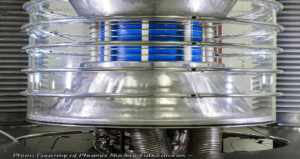As Katrina and the Waves pointed out in their 1983 hit single, “Walking on Sunshine,” sunlight serves a number of important functions: we can, of course, “walk on it” when we’re in love (thanks Katrina!); it is source of Superman’s powers (the Kryptonian would be a just another Daily Planet slub if not for how the sun converts his cells to awesomeness!); and, oh yeah, in addition, light from the sun sustains all life on Earth and is imperative to our existence.
The scientific promise of a clean, renewable energy that could be drawn from the sun began when Albert Einstein published his work on the photoelectric effect in 1905. Among his discoveries, the showboat scientist also theorized that metal absorbs light, and will retain that energy until too much light is absorbed, thus producing photons.

An aside: speaking of photons, if Superman fought Marvel superhero Photon, Photon would not be able to “absorb” Supe’s “sunlight radiation” because that’s not how the endothermic process works. I’m talking to you, u/TrashHazard! Study Kal-El before you respond to our Superman subreddits next time. Image credit: DC Comics
As the decades passed, Einstein’s theory encouraged more smart guys to begin trying to transform photons into energy. Enter Photovoltaics (or PV), which is the process of converting photons into electricity, and led to the eventual manufacture of silicon solar cells. The process of transforming sunlight into electricity, in terms of where the market for solar energy stands today, relies on silicon solar cells, in which the reasonable costs of manufacture meets relative efficiency.
(Scientists have tried, and are currently experimenting with, other semiconductor materials, but thus far, silicon remains the standard in the consumer and commercial solar energy market).
At MPF, (bolded because we stand out from competition), we design and manufacture the specialty feedthroughs that companies in the field of solar energy require to make silicon solar cells.
In what’s known as the doping stage in the creation of solar cells, silicon wafers, which will eventually be stacked into rods that conduct electricity, need to be “shot” with the elements of phosphorous and boron. This is where you need your particle accelerator like the little beauty featured below:

And this is also where you need MPF, which develops the feedthroughs so that you can create a UHV environment, allowing you to masterblast that phosphorous and boron into the silicon.
At every step in the process in creating solar cells, in fact, the temperature, pressure, speed, and the quantity of dopants needs to be monitored because the efficiency of the cells depends entirely on the quality of the silicon wafers that serve as the cells’ engine, converting sunlight to electrical energy. MPF builds the environments that maximize the efficiency of solar energy panels by ensuring that dopants register in the correct quantities, temperatures can be regulated, and pressure can be accurately gauged.
We have decades of experience in collaborating with solar energy companies that turn out the most efficient and low-cost solar panels. And we’re continuing, through arduous testing, to enable more voltage to ride through our feedthroughs. We can make cheaper, more efficient silicon solar chips, still. Blast away, particle accelerator!
The future of solar energy looks bright—you see what we did there?—and MPF will be on board to provide the next solar energy startup the specialty electrical feedthroughs (or UHV viewports) they require to, say, develop windows that accurately mimic the process of photosynthesis with microscopic bulbs of amalgamated silicon. Or…maybe something else entirely. Just wondering aloud here. Whatever the idea or discovery on the horizon in solar energy, MPF will continue to work with those in the field to harness the great powers of the sun—which was also, lest we forgot, bequeathed on our mutual pal Supes for the benefit of mankind.
Share
– Captain Jean-Luc Picard
Star Trek
Subscribe to learn more about the impossible science at MPF.
MPF Products, INC.
3046 Bramlett Church Rd.
Gray Court, SC 29645

Need Help?
No problem. Call us at (864) 876-9853 or email us at sales@mpfpi.com.